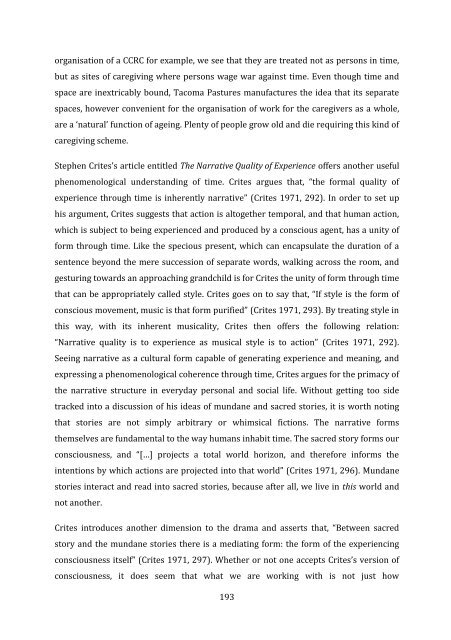Philip Y. Kao PhD thesis - Research@StAndrews:FullText
Philip Y. Kao PhD thesis - Research@StAndrews:FullText
Philip Y. Kao PhD thesis - Research@StAndrews:FullText
You also want an ePaper? Increase the reach of your titles
YUMPU automatically turns print PDFs into web optimized ePapers that Google loves.
organisation of a CCRC for example, we see that they are treated not as persons in time,<br />
but as sites of caregiving where persons wage war against time. Even though time and<br />
space are inextricably bound, Tacoma Pastures manufactures the idea that its separate<br />
spaces, however convenient for the organisation of work for the caregivers as a whole,<br />
are a ‘natural’ function of ageing. Plenty of people grow old and die requiring this kind of<br />
caregiving scheme.<br />
Stephen Crites’s article entitled The Narrative Quality of Experience offers another useful<br />
phenomenological understanding of time. Crites argues that, “the formal quality of<br />
experience through time is inherently narrative” (Crites 1971, 292). In order to set up<br />
his argument, Crites suggests that action is altogether temporal, and that human action,<br />
which is subject to being experienced and produced by a conscious agent, has a unity of<br />
form through time. Like the specious present, which can encapsulate the duration of a<br />
sentence beyond the mere succession of separate words, walking across the room, and<br />
gesturing towards an approaching grandchild is for Crites the unity of form through time<br />
that can be appropriately called style. Crites goes on to say that, “If style is the form of<br />
conscious movement, music is that form purified” (Crites 1971, 293). By treating style in<br />
this way, with its inherent musicality, Crites then offers the following relation:<br />
“Narrative quality is to experience as musical style is to action” (Crites 1971, 292).<br />
Seeing narrative as a cultural form capable of generating experience and meaning, and<br />
expressing a phenomenological coherence through time, Crites argues for the primacy of<br />
the narrative structure in everyday personal and social life. Without getting too side<br />
tracked into a discussion of his ideas of mundane and sacred stories, it is worth noting<br />
that stories are not simply arbitrary or whimsical fictions. The narrative forms<br />
themselves are fundamental to the way humans inhabit time. The sacred story forms our<br />
consciousness, and “[…] projects a total world horizon, and therefore informs the<br />
intentions by which actions are projected into that world” (Crites 1971, 296). Mundane<br />
stories interact and read into sacred stories, because after all, we live in this world and<br />
not another.<br />
Crites introduces another dimension to the drama and asserts that, “Between sacred<br />
story and the mundane stories there is a mediating form: the form of the experiencing<br />
consciousness itself” (Crites 1971, 297). Whether or not one accepts Crites’s version of<br />
consciousness, it does seem that what we are working with is not just how<br />
193
















